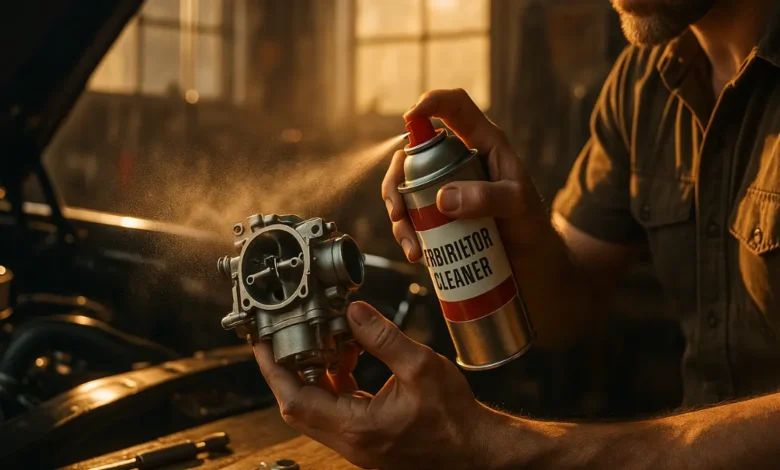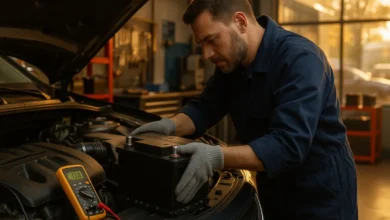Expert Guide to Carburetor Cleaner: How It Works, Why It Matters, and the Best Way to Use It

Discover how carburetor cleaner restores performance, dissolves stubborn buildup, and keeps your engine running smoothly. Learn expert techniques, tips, and best uses for lasting results.
Understanding What Carburetor Cleaner Really Is
The carburetor cleaner is more than just another can on a mechanic’s shelf — it’s the lifeline for engines that rely on carburetors to mix air and fuel. Over time, gasoline leaves behind varnish, gum, and carbon deposits inside the carburetor, restricting airflow and clogging jets. This buildup causes poor performance, hard starting, stalling, and loss of power. A high-quality carburetor cleaner removes all those deposits, restoring the carb’s ability to mix air and fuel properly.
When an engine’s carburetor gets dirty, its performance declines dramatically. The air and fuel mixture becomes unbalanced, leading to excessive fuel consumption and incomplete combustion. The carburetor cleaner breaks down these sticky residues into smaller particles that can easily evaporate or be flushed away. It acts like a deep detox for your carburetor, reaching places that physical cleaning can’t. Whether you ride a motorcycle, drive a classic car, or use small-engine equipment, carburetor cleaner helps keep your engine in its best form.
Carburetor cleaners are typically available in aerosol sprays or liquid soak formulations. Aerosols work best for quick external and throat cleaning, while liquid soaks are ideal for full disassembly and deep internal cleaning. Both rely on fast-acting solvents that dissolve tough deposits and leave a dry, residue-free finish.
Why Your Engine Needs a Carburetor Cleaner
Engines depend on precise air-fuel ratios to operate efficiently. A dirty carburetor upsets this delicate balance, leading to rough idling, sputtering, and even stalling. The carburetor cleaner becomes essential because it dissolves hardened carbon, dirt, and gum that form when fuel evaporates inside the carb. Without cleaning, those particles continue to block jets and passages, starving your engine of fuel or flooding it.
Imagine your carburetor as the lungs of your vehicle. When the passages are clogged, the “breathing” becomes labored. The carburetor cleaner works like a deep breath of fresh air, clearing the way so that your engine can inhale cleanly and exhale powerfully again. Many drivers notice an instant improvement in throttle response, acceleration, and overall smoothness after using a cleaner.
Over time, deposits can make a carburetor sticky. Choke valves, float needles, and throttle plates begin to seize or lag in response. The carburetor cleaner restores their movement, lubricating lightly as it evaporates and leaving no residue behind. Regular cleaning helps prevent expensive carburetor rebuilds and keeps older vehicles, bikes, and garden machines running like new.
How a Carburetor Cleaner Works
To understand the magic behind a carburetor cleaner, you need to know what goes on inside your carburetor. Every time fuel vaporizes, it leaves behind a trace of gum or varnish. When mixed with dust, dirt, and heat, these traces form stubborn deposits. The carburetor cleaner is designed with powerful solvents like acetone, toluene, or xylene that break down these residues at the molecular level. Once loosened, air pressure or engine vacuum carries the dissolved material away.
Unlike ordinary degreasers, carburetor cleaners are specially formulated to handle fuel-related residues. They evaporate quickly, ensuring no wet film remains that could attract more dirt. They also resist moisture, which means the cleaner doesn’t introduce water into your system. Many carburetor cleaners even contain anti-corrosion agents that protect the metal surfaces from rusting after cleaning.
In simple terms, the carburetor cleaner acts as both a solvent and a purifying agent. It penetrates the tiniest openings, dissolves the buildup, and restores the original air and fuel flow rate. When used properly, it helps your engine regain lost horsepower and efficiency.
Different Types of Carburetor Cleaner
Not all carburetor cleaners are the same. Depending on your needs, you can choose from several types:
| Type | Description | Best For |
|---|---|---|
| Aerosol Spray | Fast-acting and easy to apply without disassembly | Quick cleaning or external areas |
| Liquid Soak | Used for deep cleaning after carb removal | Full rebuilds or heavy contamination |
| Foam Cleaner | Expands to reach deep passages | Motorcycles and small engines |
| Eco-Friendly Cleaner | Solvent-free, biodegradable options | Environmentally safe maintenance |
Aerosol sprays remain the most common because they offer convenience and power in one can. Liquid soaks are better when you’re dealing with a carb that hasn’t been cleaned in years. Foam versions are gaining popularity among bikers and mechanics because they cling to surfaces longer for more effective cleaning.
When to Use a Carburetor Cleaner
Using a carburetor cleaner isn’t a one-time fix; it’s a part of routine maintenance. There are clear signs that tell you when your carb needs attention:
- Rough idling or fluctuating RPMs
- Poor fuel economy
- Hard starting, especially in cold weather
- Engine hesitation or stalling
- Black smoke from the exhaust
- Fuel odor or visible leaks near the carburetor
If you notice any of these symptoms, it’s time to clean the carburetor. Regular use of a carburetor cleaner prevents these issues before they occur. For daily-driven vehicles or motorcycles, cleaning every 6-12 months is ideal. For small engines like lawnmowers or chainsaws, cleaning at the start and end of each season keeps them healthy.
Think of carburetor cleaning like dental hygiene for your engine — consistent, preventive cleaning is far easier and cheaper than a full rebuild or replacement later.
How to Use a Carburetor Cleaner Effectively
Using a carburetor cleaner correctly ensures you get the most out of it. Follow these general steps:
Step 1: Preparation
Make sure the engine is cool and turned off. Disconnect the air filter and ensure the carburetor is accessible. Wear safety gloves and eye protection, as the cleaner is a strong solvent.
Step 2: Spray Application
Shake the can well. Spray directly into the carburetor throat, choke, and visible linkages. Use the straw for precision targeting in narrow jets and idle circuits. Allow it to soak for a few minutes.
Step 3: Start and Flush
Start the engine and let it idle. The cleaner will burn off and flush away dissolved contaminants through the exhaust. You’ll often see some white smoke — that’s normal and indicates the cleaner is doing its job.
Step 4: Deep Cleaning
For badly clogged carbs, remove the carburetor, disassemble it, and soak the parts in liquid cleaner for several hours. Scrub lightly with a nylon brush, rinse with cleaner again, and let the parts dry before reassembly.
Using a carburetor cleaner properly ensures your engine gets an even burn, smoother throttle response, and better mileage.
Safety Tips When Handling Carburetor Cleaner
Carburetor cleaner is extremely effective because it’s highly potent — but that means it should be handled with care. It’s flammable, so keep it away from heat, sparks, and open flames. Always use it in a well-ventilated area to avoid inhaling fumes. Wearing gloves prevents skin irritation, while goggles protect your eyes from accidental splashes.
Avoid spraying directly onto painted surfaces, plastic trims, or rubber gaskets unless the label specifies it’s safe for those materials. The solvents can strip paint or cause cracking in rubber parts. If you accidentally spill some, wipe it immediately with a clean cloth. Dispose of used rags and empty cans according to local hazardous-waste regulations.
By treating the carburetor cleaner as both a tool and a chemical, you’ll maintain both safety and efficiency.
Benefits of Using a Carburetor Cleaner
The list of benefits that come from using a carburetor cleaner is long, but here are the standout advantages:
- Restores Engine Power: Cleans fuel passages for smoother airflow and combustion.
- Improves Fuel Economy: Removes blockages that cause fuel wastage.
- Prevents Corrosion: Adds protective coating that reduces rust risk.
- Reduces Emissions: Ensures complete fuel burn, lowering carbon output.
- Extends Carburetor Life: Keeps internal parts free of damaging deposits.
In short, a clean carburetor equals a healthy engine. You’ll feel the difference in smoother starts, stronger acceleration, and cleaner exhaust.
Expert Quote: “A carburetor cleaner isn’t just maintenance — it’s performance insurance for any engine that breathes through jets and valves.”
Common Mistakes to Avoid When Using Carburetor Cleaner
Even experienced DIYers sometimes misuse carburetor cleaner. Here are common pitfalls to avoid:
- Spraying too little and expecting results — the cleaner needs contact time.
- Failing to clean linkages, choke valves, or idle screws.
- Ignoring air filters — dirt from a clogged filter will just re-contaminate the carb.
- Using carburetor cleaner on plastic parts that aren’t rated for it.
- Not running the engine after cleaning — which leaves dissolved debris inside.
Proper use ensures the cleaner actually does its job instead of creating new problems. Always follow manufacturer directions on duration and application method.
Carburetor Cleaner vs Fuel Injector Cleaner
While both products clean fuel systems, they serve very different functions.
| Feature | Carburetor Cleaner | Fuel Injector Cleaner |
|---|---|---|
| Main Purpose | Cleans external & internal carburetor parts | Cleans injectors & fuel lines |
| Form | Aerosol spray or soak | Liquid additive for gas tank |
| Application | Manual spray or dip | Mixes with fuel automatically |
| Use Case | Older engines with carburetors | Modern engines with EFI systems |
If your vehicle has a carburetor, the carburetor cleaner is the only product that directly targets the air-fuel mixing components. Fuel injector cleaner will not reach those jets or passages. Using the right cleaner for your system ensures optimal performance.
DIY vs Professional Carburetor Cleaning
Many enthusiasts enjoy cleaning their carburetors themselves, but there’s a time and place for professional help.
DIY Cleaning: Great for light deposits or periodic maintenance. It saves time and money, plus gives you insight into your engine’s health.
Professional Cleaning: Recommended for severe buildup, varnished internals, or when disassembly is required. Mechanics often use ultrasonic cleaners that use vibration and heat to clean parts at a microscopic level.
For most users, a regular at-home carburetor cleaner routine keeps things in top shape and prevents major repairs.
Eco-Friendly Carburetor Cleaners
In recent years, eco-friendly carburetor cleaners have gained popularity. They are biodegradable, low-VOC, and non-toxic. While not as aggressive as solvent-based formulas, they’re perfect for preventive maintenance and light cleaning. These cleaners are safe around plastic and painted parts and don’t release harmful fumes.
Environmentally conscious users often choose these to minimize health risks without compromising effectiveness. If your region restricts solvent products, these alternatives offer a responsible way to maintain your carburetor safely.
Storage and Shelf Life of Carburetor Cleaner
Proper storage is key to preserving the cleaner’s effectiveness. Keep it tightly sealed, in a cool, dry place, away from direct sunlight. High temperatures can cause pressure buildup inside aerosol cans, leading to leaks or reduced potency. Most carburetor cleaners last for several years if stored correctly.
Avoid puncturing or disposing of the can in fire. Once the cleaner runs out, recycle the empty container responsibly. Following these storage guidelines ensures that when you grab that can months later, it’s still ready for action.
Frequently Asked Questions
What does carburetor cleaner actually do?
It dissolves dirt, gum, varnish, and carbon from carburetor passages, jets, and valves to restore smooth airflow and balanced fuel delivery.
Can I use carburetor cleaner while the engine is running?
Yes, many spray cleaners are safe to use with the engine idling. Always follow safety instructions, and avoid overspraying near hot parts.
Is carburetor cleaner safe for rubber and plastic?
Not always. Some strong solvents can damage rubber seals or plastic parts. Always check the label before applying directly.
Can carburetor cleaner fix a non-starting engine?
It can help if the cause is a dirty carburetor. However, mechanical or electrical problems won’t be solved by cleaner alone.
How often should I clean my carburetor?
For regular vehicles, every 6-12 months is sufficient. For seasonal tools like lawnmowers, clean before and after storage.
Can I substitute carburetor cleaner with other solvents?
No. Generic solvents or brake cleaners can damage the carb’s internal coatings or seals. Always use a dedicated carburetor cleaner.
Conclusion
A carburetor cleaner might seem simple, but it’s the unsung hero of smooth engine performance. It restores lost power, improves fuel economy, and prevents major mechanical failures. Whether you’re maintaining a motorcycle, classic car, or lawnmower, keeping your carburetor clean ensures every drop of fuel turns into pure driving power.
Regular use of carburetor cleaner doesn’t just clean — it preserves your engine’s legacy, efficiency, and heartbeat. Treat your carburetor with care, and it will reward you with reliability and performance for years to come.





